Exploring the Habitat of Bottlenose Dolphins
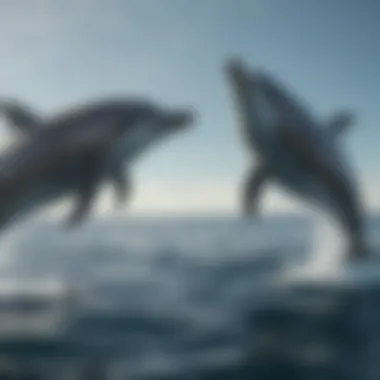
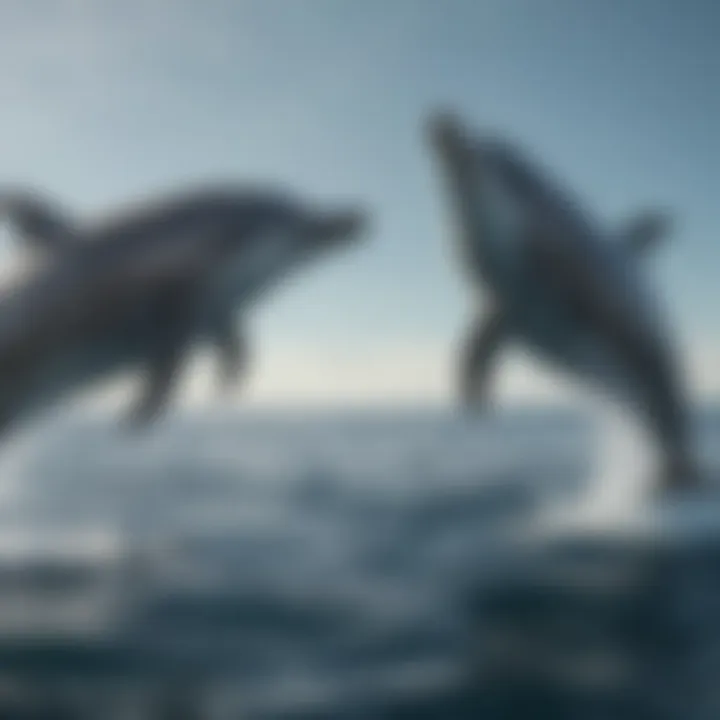
Nature Topic Overview
Bottlenose dolphins are fascinating creatures that dazzle both young and old alike. These marine mammals are smart, playful, and known for their friendly nature. Understanding their habitat is crucial for grasping how these dolphins thrive in various environments around the globe. They primarily dwell in shallow coastal waters, bays, and estuaries, yet they can easily adapt to diverse marine settings. From the warm waters of tropical seas to temperate regions, bottlenose dolphins find the key ingredients they need to survive and flourish.
The ecological factors influencing their lifestyles include temperature, water salinity, and the availability of food. By exploring these aspects, readers can appreciate not only where these dolphins live, but why they prefer these special locations.
Fun Facts and Trivia
Did you know that bottlenose dolphins can hold their breath for up to 15 minutes while diving? Or that they communicate using a variety of clicks, whistles, and body movements? Here are a few more captivating facts that might surprise you:
- Bottlenose dolphins can swim up to 25 miles per hour! That’s as fast as a car on a highway.
- They often play and surf on waves, showing off their acrobatic skills.
- A group of dolphins is called a pod, and they can range from just a few members to hundreds.
Visual aids, such as colorful illustrations or videos showing their aquatic antics, can make learning about these dolphins even more thrilling for kids!
Wildlife Explorations
Aside from bottlenose dolphins, many other marine creatures share their habitat. For instance, you might find sea turtles gliding gracefully or various fish species darting through the water. Here are some notable companions in the same ecosystems:
- Manatees: Also called sea cows, these gentle giants are known for their slow movements.
- Sea otters: These playful animals often use tools to crack open shellfish.
- Various fish: From colorful clownfish to shimmering schools of sardines, the aquatic life is diverse.
Engaging details about these animals can bring their habitats to life. Perhaps a quiz or puzzle about marine life can spark children's interest further!
Environmental Awareness
As the oceans face challenges like pollution, climate change, and habitat destruction, the importance of conservation comes into focus. By learning about the habitats of bottlenose dolphins, young readers can understand the impacts of their actions on these delicate ecosystems.
Here are some ways kids can help protect marine environments:
- Reduce plastic waste by using reusable bags and bottles.
- Support local clean-ups of beaches and waterways.
- Spread awareness about marine conservation in their communities.
DIY Nature Activities
Children can put their newfound knowledge into practice with fun and educational activities:
- Create a dolphin craft: Using paper plates and markers, kids can make their own dolphins to hang on their walls.
- Nature journal: Encourage them to start a journal where they can note down observations of local wildlife.
- Outdoor explorations: Organize a visit to a nearby beach or aquarium, allowing kids to witness marine life up close.
These hands-on activities help reinforce their learning while promoting a love for nature.
"Understanding the natural world is the first step towards protecting it."
With each section of this article, we aim to inspire a deeper connection not just with bottlenose dolphins but also with the beauty and fragility of our oceans.
Prologue to Bottlenose Dolphins
Bottlenose dolphins, those agile and intelligent creatures, have a special place in our oceans and in our hearts. Understanding them is not just about knowing their habits or habitats; it’s about appreciating a vital part of our marine environment. This section sets the stage for a deeper journey into the world of these fascinating mammals. By exploring their characteristics, behavior, and the unique roles they play in marine ecosystems, readers can begin to grasp why these creatures matter.
Overview of the Species
Bottlenose dolphins, scientifically known as Tursiops truncatus, are among the most well-known dolphin species globally. Their playful nature often catches the eye of beachgoers and marine enthusiasts alike. Typically, they sport a robust body with a slightly curved mouth that gives them that permanent smile. An intriguing fact is that their skin color varies; they can range from gray to a lighter shade, sometimes almost overlooking them in the playful waves. Normally growing up to 12 feet in length, these dolphins can weigh anywhere from 300 to 1,400 pounds. Powerful and sleek, they are the athletes of the sea, capable of swimming at impressive speeds.
Bottlenose dolphins are social animals and often group in pods that can vary from just a few to over a hundred individuals. This social structure is crucial since their interactions and relationships within these groups enhance their survival. They not only communicate with each other through a series of whistles and body language but also display signs of strong bonds. Given their intelligence, they’re known to use tools and even engage in cooperative hunting strategies, showcasing behaviors that mirror those often associated with primates.
Importance in Marine Ecosystems
Dolphins are integral to the health of marine ecosystems, acting like ecological sentinels. Their presence indicates a balanced environment. When we look at the dynamics of the ocean, bottlenose dolphins serve as both predator and prey, influencing the populations of fish and other marine species. Their foraging habits help maintain the populations of fish species, ensuring that no single species overwhelms the ecosystem.
The importance of bottlenose dolphins extends beyond just their role as predators. They help with nutrient cycling in marine environments. Through their waste, they release nutrients that become food for smaller marine organisms, creating a cycle that supports life underwater. Without healthy dolphin populations, the entire marine community could suffer.
"Bottlenose dolphins are key figures in the ocean's story, linking various species and their environments in complex and essential ways."
In summary, understanding bottlenose dolphins enriches our knowledge of marine ecosystems and highlights the importance of conservation efforts. These unique creatures do more than swim; they are crucial players in the survival of their environments. Recognizing their significance encourages respect and vigilance in protecting our oceans.
Geographical Distribution


Understanding where bottlenose dolphins reside is crucial to grasping their way of life. The geographical distribution helps illuminate the various ecosystems they inhabit and the specific traits of these environments that cater to their survival needs. Different areas around the globe offer unique features, each playing a role in the dolphins' behaviors, social structures, and even their feeding habits. Recognizing these regions assists in safeguarding dolphin populations and their habitats, ultimately contributing to the health of marine ecosystems overall.
Global Range of Bottlenose Dolphins
Bottlenose dolphins have quite the expansive range. They are primarily found in warm waters, but their reach stretches from tropical waters to temperate regions. This adaptability is one of their core strengths. Most populations thrive in coastal areas, although you can also spot them in some oceanic environments. Generally, these dolphins prefer regions where the water temperature averages between 20 to 30 degrees Celsius. This preference guides them to areas rich in food and favorable conditions for breeding.
Some key locations where bottlenose dolphins can be seen include:
- Atlantic Ocean
- Pacific Ocean
- Mediterranean Sea
- Caribbean Sea
Through continuous observation and research, scientists have found that bottlenose dolphins can migrate between habitats, seeking out areas with abundant food sources or optimal social structures.
Specific Habitats Worldwide
Diving deeper, let’s explore the specific habitats that play host to these intelligent creatures.
Coastal Areas
Coastal areas are often like a buffet for bottlenose dolphins. These locations are packed with nutrients and marine life, making them an attractive option for feeding and socializing. The shallower waters found here support various species of fish, crabs, and mollusks, which are vital food sources for the dolphins.
What makes coastal areas quite unique is their variability. One day, a dolphin might cruise the warm, sandy beaches of Florida, while the next it could be exploring the rocky shores of California. This adaptability is a key advantage, allowing them to exploit different environments. However, this proximity to human activities sometimes brings challenges, such as pollution and boat traffic, which can have adverse effects on their well-being.
Open Oceans
Contrasting greatly with coastal regions, open oceans offer vast spaces and less human interference. Here, bottlenose dolphins navigate the bigger blue in a free yet solitary manner, often seen hunting in smaller pods. One of the primary benefits of open oceans is the availability of those larger fish species that often form schools in the deeper waters.
Yet, these areas do come with their own set of challenges. The open sea can also be unpredictable, with rough weather and changing currents. Many dolphins must constantly adapt their strategies for hunting and navigation.
Estuaries
Estuaries serve as the meeting point for fresh and saltwater—an environment rich with biodiversity. For bottlenose dolphins, estuaries are beneficial for several reasons. These regions usually teem with small fish, crustaceans, and other prey, providing ample hunting opportunities. Plus, estuaries are often less turbulent than open ocean, giving dolphins a sense of safety.
The unique structure of estuaries, with their clear and shallow waters, allows for easy maneuvering and hunting. However, they are also sensitive areas susceptible to pollution and habitat degradation. Protecting estuaries is vital for the long-term survival of bottlenose dolphins and many other marine organisms.
"The habitats of bottlenose dolphins are as diverse as the dolphins themselves – they adapt to survive, thriving in various environments around the world."
As we can see, understanding the geographical distribution and specific habitats is not just about knowing where bottlenose dolphins live. It is essential for appreciating the delicate balance of their ecosystems and the vital role they play in marine environments.
Preferred Habitats
Bottlenose dolphins are not just wanderers of the sea; they are selective about where they call home. Preferred habitats play a crucial role in their survival and overall well-being. These environments provide not just shelter but also food sources and safety from predators. Different dolphins will show unique traits as they adapt their behavior and social structures to suit various habitats. Understanding these choices is key to grasping how these dolphins thrive.
Behavioral Adaptations
Bottlenose dolphins are clever creatures who adapt their behavior based on their living conditions. When they find a cozy nook or cranny, they often exhibit fascinating behaviors that help them survive. For instance, in coastal waters, they might use echolocation to locate fish hiding in sand or rocks. This ability shields them, as they can eat without fear of being spotted.
Another notable behavior is their social interaction. In the warmer shallows, close to urban settings or tourist areas, they frequently engage in playful activities. These don’t merely look fun; they also serve as practice for hunting techniques and communication skills. Dolphins in more sheltered waters might form larger pods that can provide safety in numbers. Their adaptability is a true testament to their intelligence.
Physical Characteristics of Preferred Environments
Water Salinity
Water salinity refers to the amount of salt in the water, and it varies greatly from one habitat to another, which has a significant impact on bottlenose dolphins. Generally, they prefer waters where salinity is moderate. This is key for several reasons.
- Health: Dolphins thrive in environments with the right balance of salt. Too salty or too fresh water can lead to health challenges. It’s like finding the perfect seasoning for a dish; balance is everything.
- Prey Availability: Many fish species that dolphins enjoy are most abundant in waters with consistent salinity levels. They often flock to regions where the mix of salt and fresh water helps attract small fish.
In these environments, dolphins can hunt efficiently and maintain their energy levels.
Temperature Preferences
Temperature preferences are another essential aspect of bottlenose dolphin habitats. These mammals generally enjoy warmer waters, typically ranging from 15 to 25 degrees Celsius. Warmer temperatures provide many advantages.
- Comfort: The warmth helps dolphins maintain their body temperature, making it easier for them to conserve energy.
- Breeding: Warmer waters are often more conducive to reproduction. Dolphins are known to prefer areas where water temperatures create a nurturing environment for calves. This is critical for the survival of the next generation.
However, rising sea temperatures due to climate change pose a serious threat to their preferred habitats. Such changes could push dolphins away from their traditional homes, leading to potential competition with other marine species for food and space.
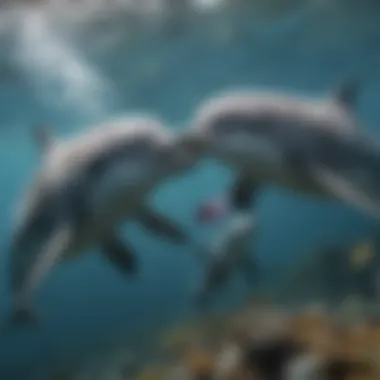
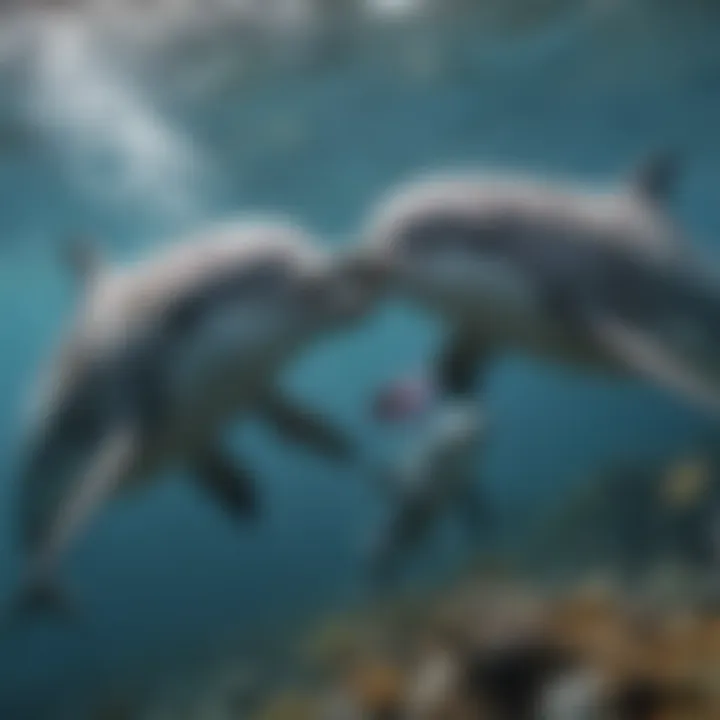
"The balance of nature is delicate. Understanding the preferences of dolphins can help ensure these beautiful creatures continue to thrive in our oceans."
In summary, the understanding of bottlenose dolphins' preferred habitats sheds light on their behavioral adaptations and physical characteristics needed for their survival. Creating awareness about these important aspects contributes to ongoing conservation efforts.
Bottlenose Dolphin Habitats in Detail
The habitats of bottlenose dolphins serve as vital ecosystems, helping to nurture these intelligent creatures. Understanding these environments sheds light on their behavior, feeding habits, and social structures. This section highlights the unique aspects of bottlenose dolphin habitats, including warm coastal waters and urban areas. By exploring these elements, we can appreciate the importance of preserving these environments, which are essential for the survival of this species.
Warm Coastal Waters
Regions with Abundant Marine Life
Warm coastal waters are a haven for bottlenose dolphins. These environments typically feature rich biodiversity, which means there's a treasure trove of food sources available. Schools of fish, crab, and other marine creatures thrive in these areas. This plentiful buffet is a key characteristic that draws dolphins to coastal regions.
These regions often have nutrient-rich waters due to currents and upwellings, creating an ideal setting for marine life. The health of these ecosystems directly impacts the dolphins’ ability to find food. For instance, when the waters are healthy and support a wide variety of species, the dolphins can flourish. Conversely, if these regions suffer from decline due to pollution or overfishing, the dolphins face challenges in securing their meals. This makes warm coastal waters not only beneficial, but vital for their survival.
Impact of Temperature
Temperature plays a crucial role in deciding where bottlenose dolphins choose to inhabit. They typically prefer water temperatures ranging between 10 to 30 degrees Celsius. This range reflects their need for warmer waters, which also tend to host abundant marine life. When water temperatures fluctuate beyond this range, dolphins may need to adapt their behavior or migrate to find comfort.
Warm waters not only support marine life but also influence the dolphins’ overall health. In warmer environments, dolphins are less likely to experience health issues related to colder climates, like hypothermia. Furthermore, the comfort of warmer temperatures can enhance their social interactions. This makes temperature a significant consideration when discussing bottlenose dolphin habitats.
Urban Areas and Their Adaptability
Despite their natural inclination toward coastal waters, bottlenose dolphins have shown remarkable adaptability to urban environments. Coastal cities often mean bustling human activity, but they also provide opportunities. These areas can offer rich feeding opportunities, especially in marinas and ports, where fish gather.
On one side, urban habitats present unique challenges. Pollution is a major concern, as contaminated waters can harm dolphins. However, the adaptability of these animals is impressive; they modify their hunting strategies and even social structures to fit their changing environment. This adaptability showcases their intelligence and resilience in the face of human-induced changes to their habitats.
Feeding Grounds
Feeding grounds serve as critical areas where bottlenose dolphins find sustenance. These regions are not just random spots; they are integral to the dolphins' diets and overall health. Understanding how these feeding grounds function gives us insight into the complexities of their natural habitats and the delicate balance within marine ecosystems. Dolphins, known for their intelligence and adaptability, rely heavily on these environments to thrive.
Impact of Habitat on Diet
The habitat where bottlenose dolphins reside has a profound impact on their diet. Different environments offer varied types and quantities of prey. For example, in coastal waters rich with nutrients, dolphins enjoy a feast of fish, squids, and crustaceans.
- Nutrient-Rich Coastal Waters: Areas near rivers or upwelling zones are packed with life. The flow of freshwater brings nutrients that support large schools of fish.
- Depth and Structure: The underwater landscape influences which prey species are available. Dolphins often hunt in depths that match their prey's habitat preferences.
Furthermore, the type of habitat can dictate how much energy dolphins expend while hunting. Shallow waters, filled with abundant food resources, allow for efficient foraging. In contrast, open ocean environments might require more energy to locate food, since prey can be dispersed and less predictable. Thus, where dolphins choose to hunt impacts not only their food intake but also their energy balance.
Hunting Strategies in Different Environments
Bottlenose dolphins have honed unique hunting strategies tailored to their environments, showcasing their adaptability. These strategies are shaped by the available resources, the type of prey, and the environmental conditions.
- Coastal Hunting: In shallow coastal areas, dolphins use a technique called strand feeding. They swim close to the shore and rush onto the sand, trapping fish in shallow water, before safely retreating back to the sea. This method is both clever and effective.
- Deep Sea Techniques: In deeper waters, dolphins may employ cooperative hunting tactics. They work in groups to herd fish into tight balls, making it easier to catch them. This social method enhances their success rates and demonstrates their ability to communicate and coordinate.
- Echolocation: Another fascinating aspect is the use of echolocation. Dolphins send out sound waves that bounce off objects, including prey, helping them locate food even in murky water.
These strategies not only highlight the dolphins' remarkable intelligence but also emphasize the relationship between their feeding grounds and their health as a species. Without suitable habitats, their hunting methods may become less effective, threatening their survival.
"The link between habitat and diet is a cycle of interdependence, demonstrating that the health of one influences the other."
Social Structures and Group Dynamics
Understanding the social structures and group dynamics of bottlenose dolphins reveals how these marine mammals thrive in their environments. Dolphins are, by nature, social creatures. They form intricate relationships that go way beyond just sharing the water. This social behavior is critical for their survival and overall well-being.
Pods and Social Hierarchies
Bottlenose dolphins typically live in groups called pods. These pods can range from just a few dolphins to several dozen, depending on the circumstances. Each pod has its own hierarchy. Most often, you’ll find a matriarch leading the group, usually an older female who has experience in locating food and safety. The bonds within a pod are quite strong, and often, you'll see dolphins working together to hunt or protect one another from threats.
- Cooperative Hunting:
One fascinating aspect of pod dynamics is cooperative hunting. Dolphins will often chase schools of fish into tight groups. It’s a strategy that requires coordination, communication, and teamwork, showcasing their intelligence. When they hunt in groups, they can catch more fish, which is a win for the whole pod. - Strong Family Bonds:
These dolphins have been observed nurturing their young and staying together for many years. They engage in playful behavior that strengthens these relationships, making their social fabric complex and vital for raising pups successfully.
Migration Patterns and Their Influence
Migration isn’t just a word for birds. Bottlenose dolphins also migrate, often in search of warmer waters or richer feeding grounds. The migration patterns of these dolphins often depend on the availability of fish and even changing water temperatures.
- Influence of Seasonal Changes:
As seasons change, so do their hunting and social strategies. For example, during winter months, dolphins may be found closer to the shore where the ocean is warmer, and food is abundant. When the temperatures rise, they might head back to deeper waters, reflecting how deeply their migration patterns are tied to environmental conditions. - Learning and Adaptation:
Younger dolphins observe and learn from their elders. They pick up invaluable skills that aid their survival. This transfer of knowledge emphasizes the importance of social structures in keeping the group cohesive and thriving.
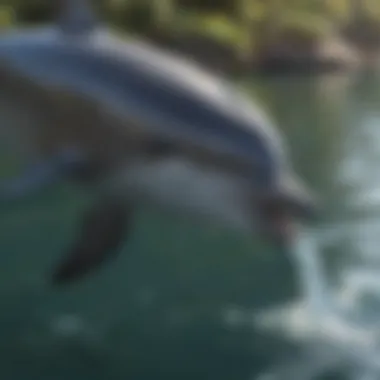
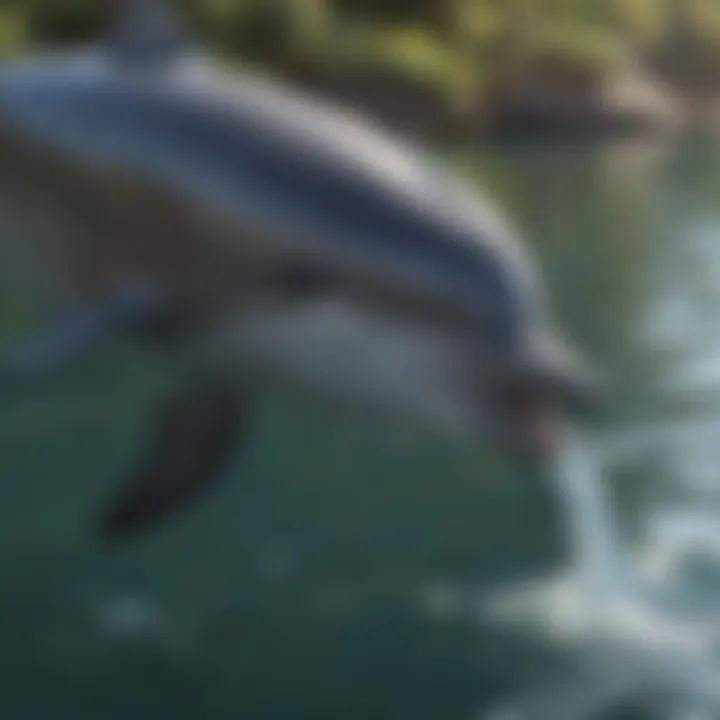
"The social behavior of dolphins is like a concert—individuals play specific roles, but together, they create harmony in the ocean."
Challenges to Bottlenose Dolphin Habitats
Understanding the challenges that bottlenose dolphins face in their habitats is crucial for grasping the full picture of their existence. Unlike many land mammals, these marine creatures often interact with their environments in intricate ways. Human actions—both direct and indirect—have created significant obstacles that impede the wellbeing of these dolphins and their ecosystems. By studying these challenges, we can gain insight into the complexities of marine life and recognize the importance of conservation.
Threats from Human Activity
Pollution
Pollution comes in many shapes and sizes, each presenting unique dangers to marine life. For bottlenose dolphins, elements like plastic waste and chemical runoff are especially perilous. Plastics not only clutter their environments but can also be ingested accidentally, leading to health complications. Additionally, toxic substances can seep into the water, resulting in harmful algal blooms, which further degrade the quality of the habitat. By examining these aspects, we can spotlight pollution as a key factor diminishing the quality of dolphin habitats.
One significant characteristic of pollution is its persistence. Chemicals can linger in the ocean for years, slowly accumulating in the food chain. Dolphins, at the top, find themselves with elevated toxin levels, which can seriously affect their reproduction and overall health. Furthermore, marine debris can harm young dolphins as they learn to navigate their environments. It's imperative to convey these points in order to incite action among those who care for marine ecosystems. Pollution is a glaring issue that cannot be ignored.
Fishing Practices
Fishing practices pose another serious threat to bottlenose dolphins, often raising a host of complications. The practices that are most detrimental include bycatch—where dolphins unintentionally get caught in fishing nets—and overfishing, which depletes their food sources. This practice not only endangers their populations but also disrupts the delicate balance of their habitats.
The key characteristic here is the susceptibility of dolphins to these fishing methods. Fishermen may not intend to cause this harm, yet the consequences ripple through the dolphin populations. Bycatch not only results in dolphin fatalities but can also cause injuries that affect their ability to hunt. Understanding these fishing methods is vital because it allows for more responsible practices to emerge. Overfishing, too, leads to a scarcity of fish, making it tough for dolphins to thrive. Raising awareness about sustainable fishing can lead to better practices that align with the needs of marine life.
Climate Change Impact
Climate change may feel like an abstract concept to some, but its effects are stark and immediate for bottlenose dolphins. Rising sea temperatures can alter the distribution of their prey. This may drive dolphins to migrate longer distances in search of food, which can disrupt established social structures. Additionally, changes in ocean currents can affect nutrient flow, further complicating the ecosystems dolphins rely on.
In some areas, climate change can lead to loss of habitat, particularly in coastal regions. Sea level rise can erode shorelines where dolphins find shelter and breeding grounds. Coral reef degradation, often accelerated by temperature changes and ocean acidification, also threatens the delicate balance of dolphin habitats. If we don’t take these challenges seriously, the implications could be dire for not just bottlenose dolphins but for entire aquatic ecosystems.
"The complex interplay of human actions and climate change can wreak havoc on the delicate marine ecosystems that bottlenose dolphins depend on for survival."
As we dissect these challenges, it becomes increasingly clear that concerted efforts are essential in tackling these threats. Whether through reducing pollution, advocating for better fishing practices, or addressing climate change, every action counts in protecting the habitats of these remarkable creatures.
Conservation Efforts
Conservation efforts are critical for the survival of bottlenose dolphins, a species that plays a significant role in marine ecosystems. As we investigate the various strategies in place, it becomes clear that protecting these marine mammals is not just about keeping them safe; it's about ensuring the health of the oceans as a whole. By safeguarding their habitats, we support the numerous species that share these ecosystems, thus preserving the intricate balance of nature.
Protecting Dolphin Habitats
Ensuring the protection of dolphin habitats requires multi-faceted approaches. Key steps include:
- Establishing Marine Protected Areas: These are zones where human activity is limited, helping to maintain a healthy environment for dolphins and other marine life.
- Implementing Sustainable Fishing Practices: Overfishing can deplete dolphin prey. Regulations that promote sustainable fishing can mitigate this risk.
- Pollution Control Measures: Reducing runoff from agriculture and urban areas can help keep ocean waters clean and safe for dolphins.
- Monitoring Dolphin Populations: Regular assessments help track the health of dolphin populations and the effectiveness of conservation efforts.
The role of government organizations and environmental groups is vital in these areas. They work to create policies and laws that prioritize habitat protection. Local initiatives often involve educating communities about the importance of maintaining water quality and preserving coastal ecosystems, fostering a sense of stewardship among residents.
"A clean ocean is vital for all marine animals. Protecting their homes ensures they can thrive, and in turn, keep our ecosystems balanced."
Role of Community Engagement
Community engagement provides a solid foundation for conservation efforts. When local populations are actively involved in protecting dolphins, the chances of success increase tremendously. Here are some key elements of effective community engagement:
- Education and Awareness Campaigns: Teaching children and adults about bottlenose dolphins and their habitats helps foster a protective attitude. Workshops, school programs, and community events also play a part in spreading knowledge.
- Citizen Science Projects: When residents participate in projects to monitor dolphin sightings or collect data, it not only aids scientific research but also deepens their connection with marine life.
- Volunteering for Clean-up Events: Organizing local beach clean-ups encourages community members to take an active role in keeping oceans clean from debris that could harm dolphins.
- Promoting Responsible Tourism: Informing tourists about respecting marine habitats contributes to better practices that protect dolphins. Tour guides can emphasize the importance of observing dolphins from a distance without disturbing them.
Community engagement builds a bridge between the dolphins and the people living near their habitats. When individuals invest their time and effort in conservation, it nurtures a culture of respect for nature that resonates for generations. This collective effort can spark various local initiatives that not only support dolphins but also uplift the community as a whole.
End
As we wrap up our journey into the habitat of bottlenose dolphins, it's crucial to reflect on why this topic truly matters. Bottlenose dolphins are not just fascinating creatures; they serve as significant indicators of the health of our oceans. Understanding their habitats can help us grasp the wider impacts human activities have on marine ecosystems. The conservation of these environments is not a mere obligation, it's essential for maintaining the biodiversity and balance of marine life.
The Future of Bottlenose Dolphins
The future of bottlenose dolphins hinges on our collective actions today. As climate change continues to alter sea temperatures and ocean chemistry, these dolphins may be pushed to adapt in ways we cannot fully predict. In many coastal regions, increased pollution and habitat destruction threaten their well-being.
To ensure a secure future for bottlenose dolphins, it’s important that governments, organizations, and local communities work together. Pollutants must be reduced, marine protected areas established, and sustainable fishing practices adhered to. Keeping our oceans clean is not just for the dolphins; it benefits all marine and terrestrial life. We must foster innovative approaches to promote harmony between human endeavors and natural ecosystems.
Importance of Education and Awareness
Education is a powerful tool in preserving the habitats of bottlenose dolphins. Raising awareness among children and adults about the importance of these dolphins and their environmental roles can inspire conservation efforts. By informing the public, we create a generation of informed citizens who value marine life.
Fostering a love for these creatures can start in schools through fun and interactive learning activities. For parents and teachers, discussing documentaries, books, or even virtual reality experiences focusing on marine biology can spark curiosity. Opportunities to engage in local beach clean-ups or wildlife protection initiatives provide hands-on experiences that deepen understanding.
"Education is the most powerful weapon which you can use to change the world." – Nelson Mandela.
A collective effort in education and awareness can shape policies to protect our oceans and the life within them, including the beloved bottlenose dolphins. Ultimately, it falls to us to ensure future generations can witness these remarkable animals in their natural habitats.







